Route: 253, Edinburgh to Berwick-upon-Tweed
Operator: Borders Buses
Timetable: Every 2 hours (Mon-Sat); 2 per day (Sun)
Time: ~2 hours 20 mins
Cost: £11 Single
Date of Trip: 1/5/19
Berwick Cantona: Ian & Eleanor
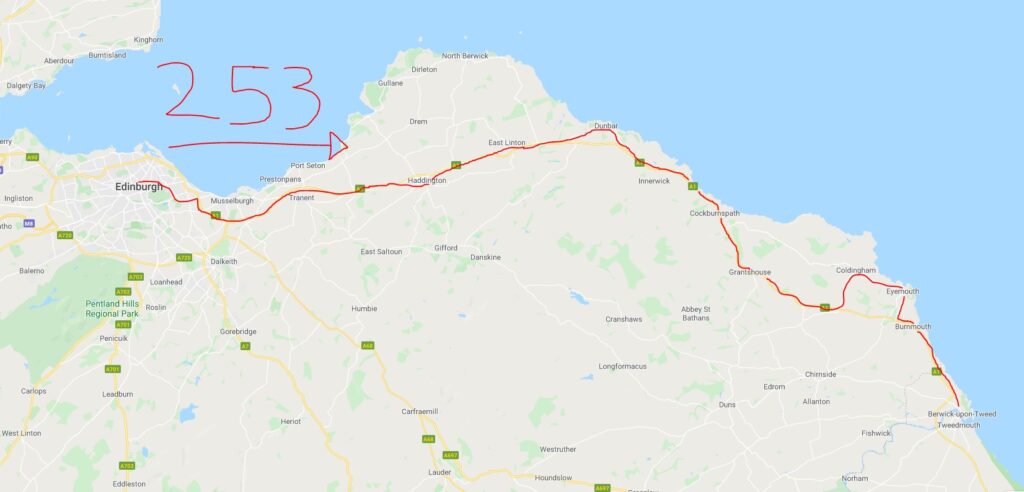
Blade Runner’s dystopian vision of Los Angeles feels homely compared to Edinburgh Bus Station. It’s airless, with magnesium white walls and neon blue strip lights running around the perimeter, designed to discourage passengers from mainlining drugs on the concourse while awaiting the 900 to Glasgow or X59 to St Andrews.
Most of the buses which line up are coaches, really, although a handful of regular single-deckers sneak in and scurry out again without causing a nuisance. Ours is one of the latter, and we board with a pair of German tourists, whose rucksacks are so hefty they’ve developed freakish shoulder muscles more befitting of wrestlers. The man at the front has the floppiest side parting this side of Dawson’s Creek, while his friend with the russet beard and expensive DSLR camera sits just behind him. German is a language capable of stringing together incredible compound words, and is notorious for having a term for near enough every eventuality, but ‘bowling green’ is an exception.
‘Was ist ein bowling green?’ asks the man with floppy hair, after his pal mentions one in relation to ‘fotos’. Bowls is so obscure in Germany that there are no clubs in the entire country, so his bafflement at this most British of pastimes is understandable. Just wait until he realises the aim is for your wood to touch jack.

With the world still bleary-eyed, the 253 sets off at 8am on the dot, cutting a swathe through central Edinburgh’s treelined boulevards; their impressive town houses built to withstand the elemental rigours of this elevated position above the Firth of Forth. It’s a supercharged version of Bath, boosted by the added drama of Arthur’s Seat protruding high above Holyrood Park to the right, and the cadaver of the Meadowbank Stadium on the left. The only arena to have hosted the Commonwealth Games twice (in 1970 and 1986), its final crumbling concrete stand is mid-demolition, awaiting rebirth as a new sport and hotel complex.
We’re at the start of the A1 here, so it’s only proper that this first section of the UK’s longest thoroughfare is called London Road – London being its eventual southern terminus 396 miles away. It soon becomes Willowbrae Road, where Go As You Please stakes a claim for being the most Scottish funeral directors in the entire country. Its window display shows upright tartan coffins and a bright orange casket bearing the Irn-Bru logo. I don’t care what happens to my remains after I run out of steam, but I promise to do everything in my spectral powers to haunt anyone who carries me off in a branded fizzy drinks box.
As with any large city, handsomeness peters out and morphs into mundanity as we approach its outer fringes, with grand Georgian edifices replaced by double fronted bungalows and pebble dashed semis. One of them has a full model skeleton dangling from a bedroom window, shaking us back awake as we drift off in a set of road works.
After breaking through a shabby ring of retail parks, we leave Edinburgh behind and motor up the dual carriageway past tufty golf courses and into the green belt. Not that we can see much of it, as we’re encased by tall grass cuttings, leaving tantalising signs for Wallyford, Longniddry and Prestonpans to sail by unrequited.
After a dreary half an hour, we arrive in Haddington. It was Scotland’s fourth largest city in Medieval times, after Edinburgh, Aberdeen and Roxburgh, the last of which is now a tiny village a few miles from its original site. Haddington was the birthplace of Alexander II and even the Scottish flag itself, the Saltire raised for the first time at the nearby Battle of Athelstaneford in 832.
Despite being relegated to a rural outpost these days, it’s still East Lothian’s seat of governance. There are enormous mansions on the hill down into the immaculate town centre, where ancient trees hug prime spots which would’ve faced the chop had housing developers come calling in less enlightened times. Marketed as ‘The Hidden Toun’, Haddington is well away from the usual tourist trails, and although it’s stashed out of view to most (the A1 bypassed it as early as the 1930s and it hasn’t had a railway station in over seventy years), its twin high streets and tiny lanes are ripe for closer exploration.
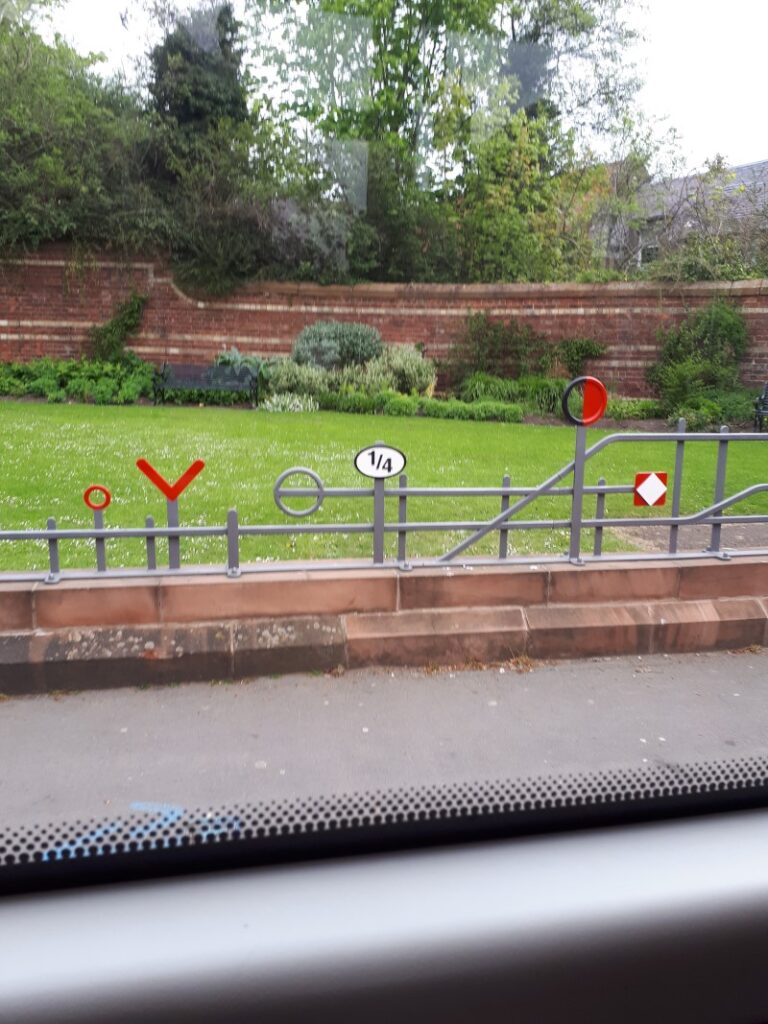
We leave the umbilical cord of the A1 for a while and take the parallel A199. The distinctive plug of Traprain Law bulges from the landscape like a swollen green blister, with wind turbine blades scything the air from the flat summits of the Lammermuir Hills behind it.
We pick up a dozen new passengers on our way into Dunbar, a pair of which are a blind woman and the waggle-tailed Labrador puppy she is training to be a guide dog. They’re only on for two stops, but it’s vital for him to get used to being constantly mollycoddled on public transport.
Dunbar itself is a beauty. There’s an antiquated feel to its bright rows of shops, where a gargantuan pestle and mortar dangles above the threshold of a chemist, and inexplicably, there’s a life-sized bride and groom fashioned out of balloons in a newsagent’s window.
We swap brief glances with the North Sea, now just yards from the road, when an old lady with lilac gloves gets on. She’s seen more of the outdoors than most, and her skin is so leathery you could make a settee out of it. She sidles up to the German lads and tells them about the impending doom today’s forecasted rain will bring. They don’t get a word in for the few minutes she’s onboard, but when she says her goodbyes at the local Asda, they’re delighted to have had an unsolicited one-way exchange about the foibles of the Scottish weather.
Just outside town, our trusty 253 heads past golden beaches and the Torness nuclear power station. A windowless grey block on the landscape, the cartoonish face on its western approach makes it look like someone designed it using Minecraft. Opened in 1988, it’s expected that the facility will last for at least another decade, but to highlight that nature always finds a way to trump technology, its reactors shut down temporarily in 2001 after their water intakes became clogged by a bloom of jellyfish.
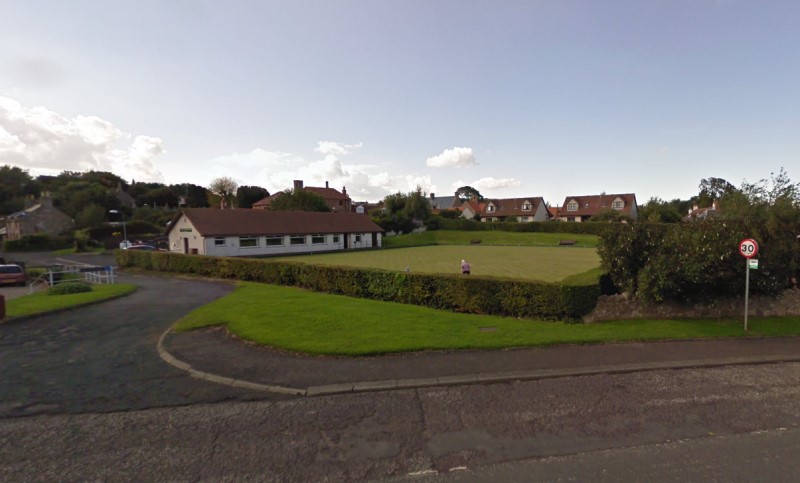
We cross into the Scottish Borders and reach Cockburnspath, a tabloid headline waiting to happen if ever there was one (it’s disappointing to learn the first syllable has a silent ‘ck’), when one of the German visitors hops up.
‘Excuse me,’ the man with the russet beard asks the driver. ‘Is this where the bowling green is, please?’
‘Aye,’ he replies, pointing to a bowls club on the opposite side of the road, ‘it’s right there.’
‘This is amazing, thank you so much.’
With the season starting just a fortnight ago, Cockburnspath Bowling Club has a green so pristine that it looks like Vidal Sassoon himself has given it a scissor cut. Its whitewashed single-storey clubhouse nestles into the grass banking which circumnavigates the playing surface, and while it’s one of the more aesthetically pleasing settings for a game of bowls, it’s a mystery why they’re so intent to snap it. Family ties, perhaps? It a dinky village of 400 souls, but Cockburnspath is the epicentre of walking routes in this corner of the country. The Sir Walter Scott Way heads west to Moffatt; the Southern Upland Way stretches beyond that to Stranraer and Portpatrick; and the Berwickshire Coastal Path winds south towards our destination, Berwick.
Pink campion and vivid yellow gorse jostle for supremacy on the verges as we head back to the A1. It’s a prettier ride here, as we crest a brow which opens views of hillsides covered in dense conifers. Sheep and cattle patrol any thimbles of land not already occupied by trees, while a handful of hares become progressively flattened in their new career as roadkill. Our first signs for English places other than Berwick zip by, showing that Newcastle, where we will end up tonight, is still 83 miles away. We place a silent offering to St. Fiacre, patron saint of haemorrhoid sufferers.
It’s a different saint Eleanor has her eye on.
‘Oh, it’s the patron saint of exercise over there,’ she says while motioning to a turn to the left.
‘Eh?’
‘St Abbs,’ she grins, her hands doing a triumphant ‘badum-tish’ drumroll in what is best described as the aftermath. This is what bus trips can do to you. You need to prepare for these unexpected dad jokes. I only wish I’d have thought of it first.
Ayton is the regional Floral Village of The Year which is surprising as there don’t appear to be any flowers in the place at all. There’s a deer relaxing in a grove of trees and a pheasant taunting the inmates from the lawn of Q’s Cat Motel, but nary a bouquet in sight.
The bus runs alongside Eye Water, a stream with the UK’s most unappealing name, which we follow into Eyemouth. It’s amazing there isn’t already a horror film character called Eyemouth, so I’ve put together a pitch…
A spindly ghoul who has mouths for eyes, he survives by crunching down on his victims’ eyeballs and grafting their optic nerves to his forehead. He suffers a terrible accident when he pops a glass eye into his main mouth and chips one of his serrated teeth. Of course, he vows revenge on the whole of humanity, starting at a party where a houseful of jocks and cheerleaders are grinding to ’90s gangsta rap and drinking illicit punch. Eyemouth devours them one by one, after which a close-up shows him wiping bloody drool from each of his gnashing maws.
Or are they tears? Is he fighting a curse? I fear we’ll never know.
Eyemouth’s lair could be the green tin shed propped up by a metal bar on the outskirts of town. With its bulbous mid-section, it looks like a tin of rotten Swedish herring on the brink of bursting, but is also where we pick up more newcomers. One of them, a woman in her 50s with a bleach blonde plait and a Jack Russell in her arms, sits just in front of us.
‘You’re no used tae buses are ye?’ she rasps to her canine companion in a voice which has finished off more cigarettes than the rest of the bus has had hot dinners, teas and breakfasts combined. To calm him down, he gets kisses and cuddles the entire way to Berwick, all reciprocated by frantic licks of her puckered lips.
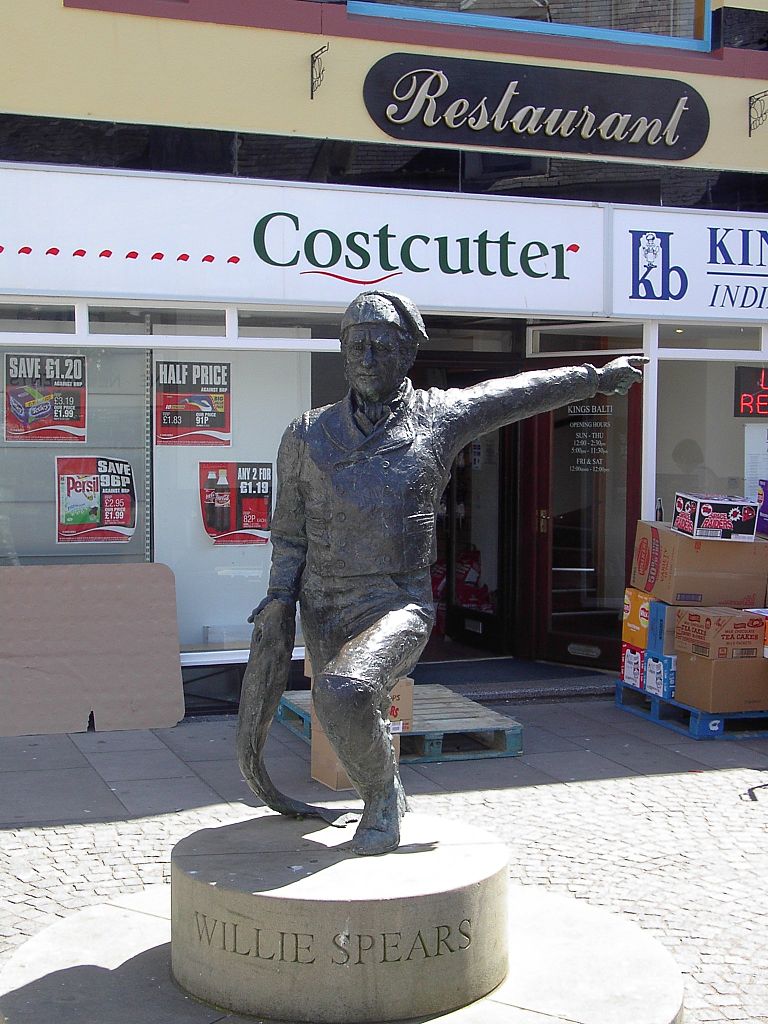
Eyemouth isn’t a place without its charms, but you need to look hard for them. The fifty shades of grey render slapped onto its properties emphasise the gloominess of the sky, and although the sea is the same colour as an iron ingot this morning, it does have the advantage of being, well, the sea.
The marketplace has a bronze statue to Willie Spears. Nicknamed the King of Fish, he led a twenty-year campaign in the mid-1800s against the tithes that he and his fellow fishermen had to pay. On top of their regular taxes, they had to set aside ten percent of their earnings to the local Church of Scotland minister, who had no intention of letting them off the hook, despite Eyemouth being the last port in the country subjected to such charges. Imprisoned for his refusal to submit to the clergy, the community rallied around to settle Spears’s fines and kirk fees.
The tithes, too, were finally paid off once and for all, yet despite the improvements made to ports throughout Scotland, the authorities let Eyemouth’s harbour go to seed. An ambitious scheme to reduce the risks of what was a dangerous landing at the best of times was eventually signed off, but just six weeks later disaster struck. A hurricane lashed Britain in October 1881 while Eyemouth’s fleet was at sea. Turning for home, twenty boats battered against exposed rocks and harbour walls, with 129 lives lost in full view of helpless families who knew the gravity of the situation and rushed to the shore. A further sixty fishermen from other ports also died that day.
Willie Spears wasn’t one of them. He warned there was a storm brewing because of depressed barometer readings, but after several weeks of awful weather, his colleagues were impatient to cast off for what would be the last time for many. Willie didn’t have many sailings left in him after that and passed away in 1885.
From our lofty perch on the cliffs beyond town, we see a trio of small vessels on the hunt for prawns and lobster, heading out to continue Eyemouth’s tradition for another generation. We are so high up that a gang of seagulls are gliding way below us, with the west coast railway line even further beneath their extended wings. The A1 widens as we approach the English border, marked by a simple stone block with the flag of St. George carved into it. It’s easy enough to miss, but there’s no song and dance about crossing into a different jurisdiction.
It’s only a couple of miles from here to Berwick, or as its welcome sign puts it, ‘The walled town of Berwick-upon-Tweed’.
Deposited outside the train station, we step straight into chilled Castle Vale Park. Dotted around the edge of its pond are thrushes, great tits and my first ever bullfinch. I’ve wanted to find one ever since I realised birds other than sparrows and pigeons existed last autumn, and the only thing stopping me punching the air is knowing that it’ll frighten it off.
The views over the Tweed stretch for miles, beyond the twenty-eight arches of Robert Stephenson’s Royal Border Bridge, which has carried the railway since Queen Victoria opened it in 1850. As much as we could dawdle here all day, we’ve got a bus to catch: the X18 to Newcastle. It’s only going to take four hours…
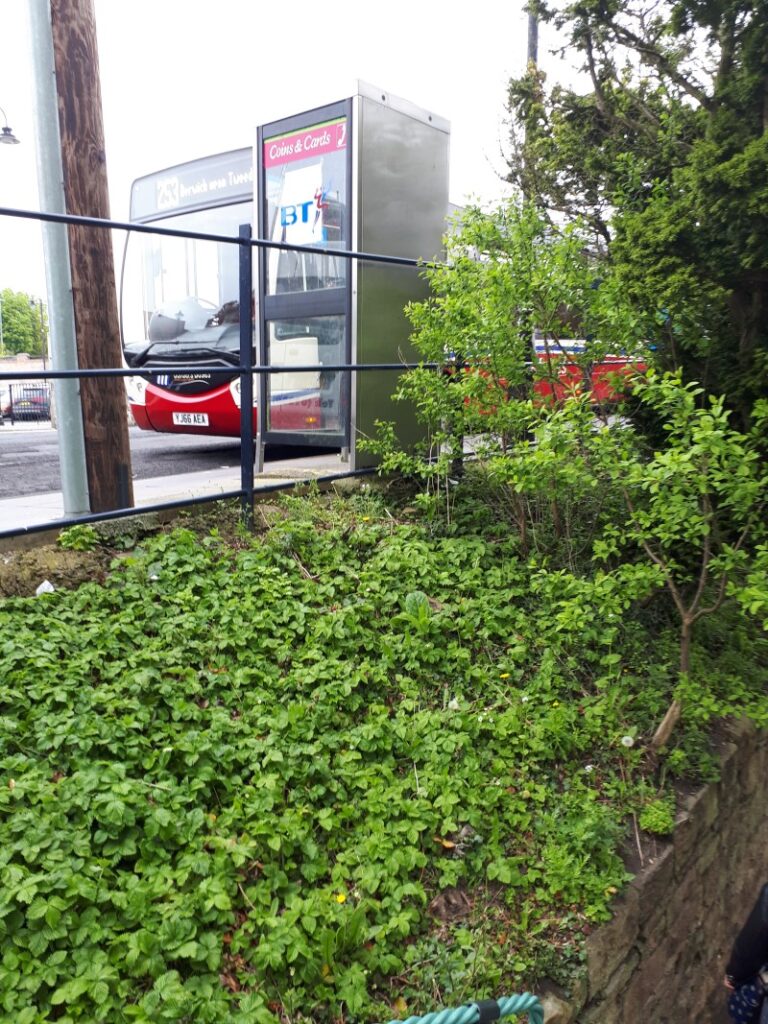
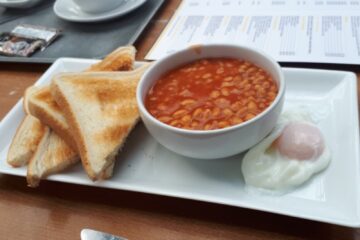
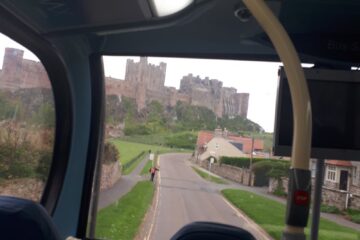
0 Comments